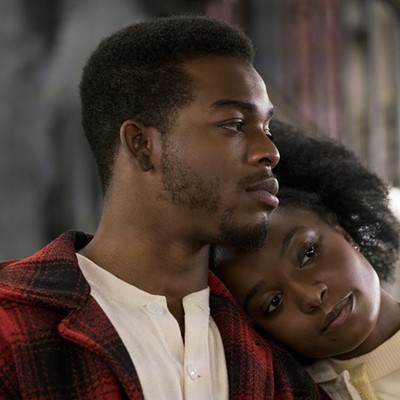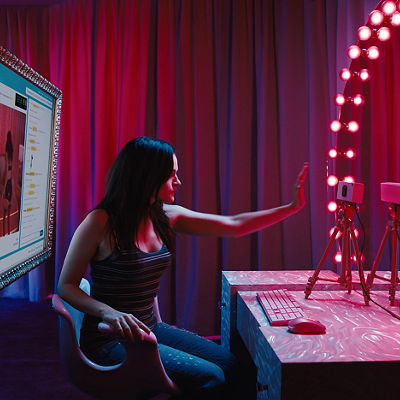If you’re a vulnerable young woman who gets hit on by lecherous older men, you might think that you could do worse than having a guy like Henry at your side. He has a low tolerance for ass grabbers, for one; he’s known to take such bird dogs by their hair and give them a smashing or two. Granted, he’s a bit squeamish about sex in general — something about his prostitute mother bringing johns back to the house, making little Henry watch, beating him, outfitting him in a dress. Sometimes his mind wanders disconcertingly — he can’t remember if he went to prison for shooting or stabbing his mother, for instance. But damned if he isn’t polite. And if you say you love him, he’ll respond, in a churlish monotone, with “I guess I love you, too.”
This is the impression of Henry that Becky, the sister of Henry’s sole friend and temporary housemate Otis, gets in John McNaughton’s Henry: Portrait of a Serial Killer. The audience gets, well, a different one, complete with Coke bottles, television sets, electric screwdrivers and lamp cords used as instruments of torture and death. Michael Rooker plays Henry with a hangdog expression that ranges subtly from blank to contemptuous; Tom Towles plays his accomplice Otis, a greasy, grimy loser with buck teeth who molests his sister and giggles with good-ol’-boy glee. They’re perhaps the most despicable movie duo in history, and they’re electrifying.
Shot on location in Chicago in 1985 for a paltry $110,000, Henry, as we now know, turned into an indie thriller cause célèbre. It was a festival favorite, and it eventually made year-end best lists. A 4K restoration of the original 16mm print of Henry, which is based on the actual confessions — few of them proven true — of real-life murderer Henry Lee Lucas, is being shown in 20 cities.
Time has not softened its most chilling moments. In the opening shots, the camera slowly pulls back from the still-open eyes of female victims, gradually revealing the lacerations that ended them; over this we hear the sounds of their violent struggles with Henry. Awful as this is to behold, the most sickening scenes not only show his deeds but emphasize the emotional upheaval of the slaughtered. A one-take, 70-second home-video shot of a whole family’s undoing plays without music in nakedly matter-of-fact fashion. Only psychopaths will be able to shake it from memory. (Ditto, given America’s still-prevalent firearms-crazed mentality, Henry’s line about “anyone” being able to buy a gun).
The restoration looks appropriately dour and grimy. No amount of fine-tuning, however, can fix Henry's amateurish stylistic qualities. Low budget or not, there is simply no reason for its reliance on clumsy fade-outs, when jump cuts would have been far more effective. The killings are too often accompanied by cornball synth theatrics and echoing ululations. And, while it achieves its goal of being thoroughly unpleasant, Henry could have used a touch more humor (beyond its one knee-slapper about the Chicago Bears). Still, it’s a gruesomely riveting sucker punch of a movie.
Support Us
Houston's independent source of
local news and culture
account
- Welcome,
Insider - Login
- My Account
- My Newsletters
- Contribute
- Contact Us
- Sign out
Henry: Portrait of a Serial Killer Returns, Undiminished in Its Cruel Power
Sam Weisberg October 26, 2016 10:00PM
[
{
"name": "Related Stories / Support Us Combo",
"component": "11591218",
"insertPoint": "4",
"requiredCountToDisplay": "4"
},{
"name": "Air - Billboard - Inline Content",
"component": "11591214",
"insertPoint": "2/3",
"requiredCountToDisplay": "7"
},{
"name": "R1 - Beta - Mobile Only",
"component": "12287027",
"insertPoint": "8",
"requiredCountToDisplay": "8"
},{
"name": "Air - MediumRectangle - Inline Content - Mobile Display Size 2",
"component": "11591215",
"insertPoint": "12",
"requiredCountToDisplay": "12"
},{
"name": "Air - MediumRectangle - Inline Content - Mobile Display Size 2",
"component": "11591215",
"insertPoint": "4th",
"startingPoint": "16",
"requiredCountToDisplay": "12"
}
,{
"name": "RevContent - In Article",
"component": "12527128",
"insertPoint": "3/5",
"requiredCountToDisplay": "5"
}
]
KEEP THE HOUSTON PRESS FREE...
Since we started the Houston Press, it has been defined as the free, independent voice of Houston, and we'd like to keep it that way. With local media under siege, it's more important than ever for us to rally support behind funding our local journalism. You can help by participating in our "I Support" program, allowing us to keep offering readers access to our incisive coverage of local news, food and culture with no paywalls.
Sam Weisberg is a regular film contributor at Voice Media Group. VMG publications include Denver Westword, Miami New Times, Phoenix New Times, Dallas Observer, Houston Press and New Times Broward-Palm Beach.
Trending Film
- International Film Festival 2000
- Jonah Hill’s Mid90s Takes an Honest Plunge Into the Millennial Past
- It’s Sadly Kind of Perfect That New Season of GLOW Is Stolen by Marc Maron
-
Sponsored Content From: [%sponsoredBy%]
[%title%]

Don't Miss Out
SIGN UP for the latest
news, free stuff and more!
Become a member to support the independent voice of Houston
and help keep the future of the Houston Press FREE
Use of this website constitutes acceptance of our
terms of use,
our cookies policy, and our
privacy policy
The Houston Press may earn a portion of sales from products & services purchased through links on our site from our
affiliate partners.
©2024
Houston Press, LP. All rights reserved.




